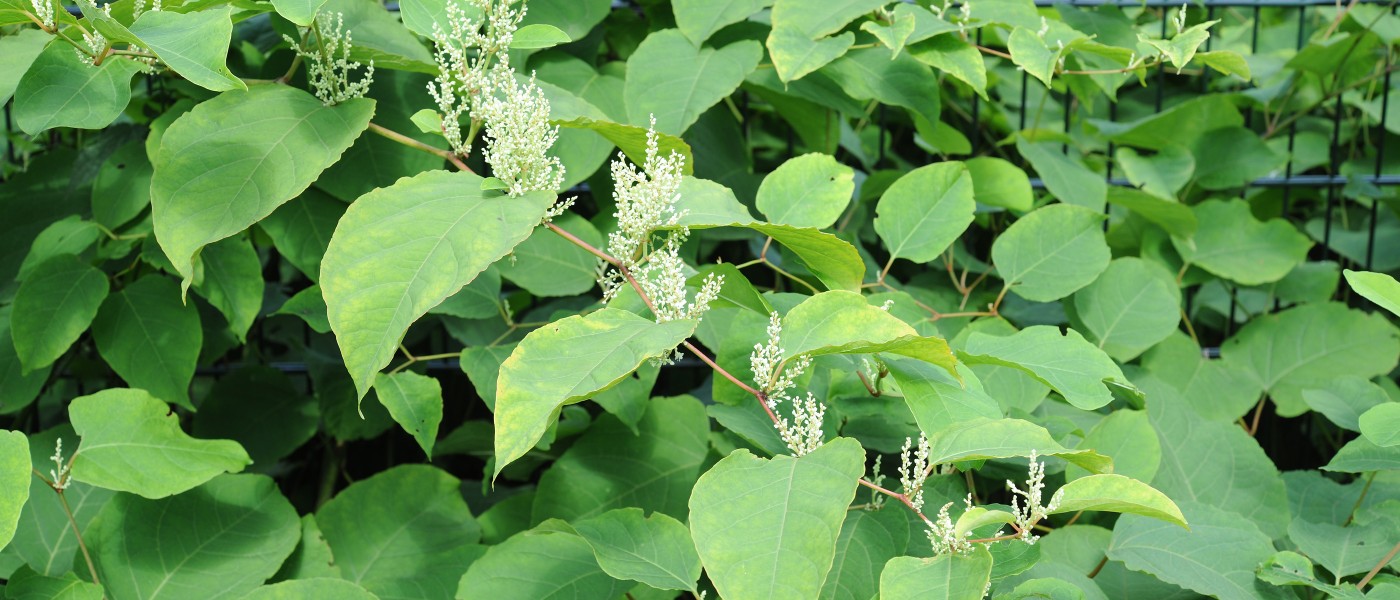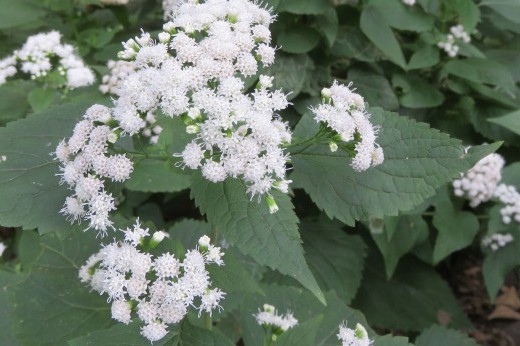Japanese knotweed, with its green-to-reddish stems that resemble bamboo, is impressive—to say the least—in its ability to thrive in harsh environments.
Known scientifically as Reynoutria japonica (also called Polygonum cuspidatum or Fallopia japonica), Japanese knotweed is a shrub-like perennial that is native to eastern Asia, where it evolved to grow near waterways, along forest edges, and in volcanic ash and recent lava flows. Known in Japan as itadori, it can thrive in disturbed ecosystems like roadsides and in soils polluted with heavy metals. Its extensive root network can secure itself on the slopes of volcanos like Japan’s Mt. Fuji, where it forms robust patches of nearly four square miles.

Unfortunately, after being transported to Europe and North America in the 19th century, R. japonica is now broadly considered, in the words of one researcher, “one of the most problematic invasive plants in the temperate world.” The qualities that make this species so miraculously resilient have helped it succeed outside of its range, where it can burst through concrete cracks and create dense monocultures that suppress nearby plant life.
Here in New York City, you might find R. japonica growing in riparian ecosystems like around the Bronx River, as well as in public parks, roadsides, empty lots, and more. At Brooklyn Botanic Garden, it’s shown up around Belle’s Brook and near the parking lot, as well as on the slope behind the Elizabeth Scholtz Woodland Garden.
Reddish-purple shoots begin to emerge in spring, by summer morphing into shrubby, leafy drifts that can reach up to seven feet tall. Its hollow stems are often reddish around the nodes, which are covered by a sheath called an “ochrea,” a distinguishing feature of the Polygonaceae or buckwheat family. In late summer, it blooms into plumes of fluffy white flowers that persist through early autumn, and its spade-shaped leaves wilt into yellow later in the fall before aboveground growth dies back in winter.
.jpg)


Serious ecological concerns notwithstanding, there’s plenty to appreciate about Japanese knotweed. Itadori, which can be translated to mean “pain puller” or “take away pain,” has been used in traditional herbal medicine in Japan, Korea, and China; herbalists in Vermont have been harvesting invasive stands to make tinctures. The rhizome contains resveratrol, also found in red grapes and blueberries, which is thought to have antioxidant and anti-inflammatory properties.
Its young spring shoots are also edible. Knotweed can be served in a variety of ways, including as a stir-fried or salted side dish popular in many Japanese homes; the pink-speckled stem has a taste similar to rhubarb. Michelin-starred restaurants are serving it, and foragers around New York City are learning to feast on it (though take care if you do so*; heavy metals are present in many urban soils, and knotweed patches are often sprayed with herbicides).

The Western history of knotweed traces back to a German doctor and botanist named Philipp Franz von Siebold, who worked for a Dutch trading settlement in Japan in the mid-1800s and collected hundreds of plants that he brought back to Europe, where he attempted to market and sell them. He promoted R. japonica as offering protection for “young plantations from wind and sun” with a rhizome “highly valued” in Japanese and Chinese medicine, and sent a shipment to Kew Gardens.
Nurseries in Europe promoted the plant as fodder for cattle and a material for matchsticks, and it was planted on estates in the U.S. in the late 19th century. South African botanist John Wood wrote in a gardening manual that after a few years in a garden, knotweed would “form a charming thicket, which must prove a pleasant feature.” (In the 1880s, British horticulturists visiting the late von Siebold’s former garden found it overtaken by R. japonica.)
Today, a quick search online and you’ll find Japanese knotweed described as a “menace,” a “horror movie,” and an “alien shrub that can’t be stopped.” The UK is in the midst of what one Slate writer dubbed “the Great British Knotweed Panic,” with lawsuits emerging amid fears of declining property values. (Knotweed has been called “Britain’s largest female,” because the weeds proliferating there are effectively clones of one of von Siebold’s original plants.)
.jpg)
R. japonica reproduces mostly asexually via thick rhizomes, or underground stems, that can extend up to nearly seven feet deep and 65 feet laterally. Tiny fragments of root and stem can also sprout new plants, so if you try to dig it up, you’ll need to get every last bit of it. Knotweed is notoriously difficult to eliminate, even with herbicides, particularly if it’s been around a while.
If you’re dealing with knotweed and hoping to manage it organically, patience is key. You can try cutting the shoots down to the ground every three months, making sure to completely defoliate, then smothering the patch with black landscaping fabric or a tarp. Rinse and repeat. By being persistent, you can weaken the rhizome by depriving it of light and chlorophyll. (Note that without chemicals, it could just send up shoots on a neighbor’s property, creating the illusion that it’s been successfully removed.)
Turning flat affected areas into lawns, with frequent mowing for many years, is another approach; you’ll need to be careful, however, not to share mowers or use flail mowers or line trimmers that can fling around knotweed fragments.
Eventually, alongside asparagus and sorrel at farmers’ markets, we may need to figure out how to live with Japanese knotweed. And if you learn to identify this plant, you can help keep it in check by carefully removing it from any land you take care of.
*Note: Forage safely! Only harvest if you have permission; most parks and gardens in New York City don’t allow visitors to remove plants. Make sure you accurately identify any plant you eat, and avoid collecting from a site you can’t confirm is free of lead or other toxins.




